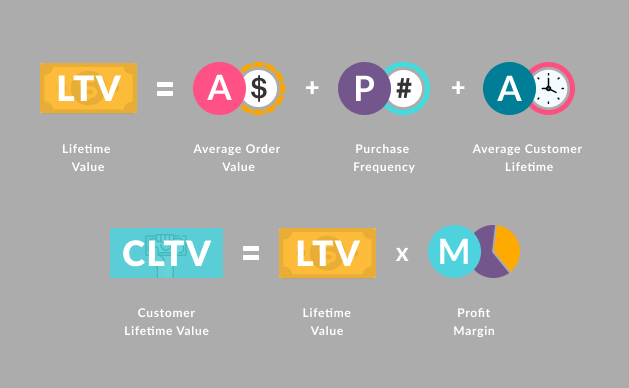
Get the latest from
Eshopbox

Key Performance Indicators (KPIs) are the metrics used to measure the performance of a business. Similarly, ecommerce metrics are the KPIs that can help online businesses evaluate their performance, set benchmarks, and take corrective measures to steer the business in the right direction.
In this ecommerce metric refresher, you will learn what is customer lifetime value (CLTV), how to calculate customer lifetime value (CLTV), why should businesses calculate customer lifetime value (CLTV), benefits of improving customer lifetime value (CLTV), and the strategies to increase customer lifetime value (CLTV).
What is Customer Lifetime Value?
Customer Lifetime Value (CLV or often CLTV) is an ecommerce metric that predicts the net profit a customer is expected to generate for your business throughout their lifetime.
The following illustration shows the customer lifetime value (CLTV) formula:

Let's see how to calculate customer lifetime value (CLTV) with an example,
- The Average Order Value (AOV) of a customer = INR 1,000
- The Purchase Frequency of the customer is three times per year for two years
- The Lifetime Value of this customer = 1000 X 3 X 2 = INR 6,000
- After calculating the cost of goods sold (COGS), overhead, marketing, and all other administrative expenses, the retailer’s Profit Margin is 20%
- The Customer Lifetime Value = INR 6,000 X 20% = INR 1,200
Note: If this customer stays with you longer, the customer lifetime value (CLTV) also increases, which means more revenue for your business.
Why should businesses calculate customer lifetime value (CLTV)?
By taking customer lifetime value (CLTV) into account, businesses can understand the value of each customer and plan revenue-oriented decisions.
There are many reasons for businesses to calculate customer lifetime value (CLTV), such as:
- Understand marketing and sales expenditure
- Analyze product development costs
- Enhance customer service
Benefits of increasing customer lifetime value (CLTV)
- Saves time and money
Acquiring new customers is five times more expensive than retaining existing customers. However, new and existing customers are equally important for a business, but resources are finite. By allocating resources on loyal customers, you can save a tremendous amount of time as well as money. Moreover, loyal customers get their friends to buy from your brand through referrals.
- Increases Return On Investment (ROI)
You can significantly reduce marketing expenditure by focusing on high-value customer groups instead of undervalued customer groups. These high-value customer group will boost your revenue with repeated purchases as they already are your loyal customers and increase the overall ROI.
How to improve your customer lifetime value (CLTV)?
There are various strategies to improve your customer lifetime value (CLTV), but it is essentially done in one of the two ways:
- Encouraging your customers to buy more products
- Keeping your customers happy with great products and exceptional service
Strategies to improve customer lifetime value (CLTV)
1. Increase your average order value
You can use merchandising techniques like product kitting —pre-built kits and custom combos, where customers purchase a set of multiple products instead of one product. Additionally, you can also provide minimum order incentives like free shipping, coupons, samples, or even direct discounts to your customers. Such techniques will increase the average order value (AOV) and ultimately improve your customer lifetime value (CLTV).

2. Upsell your products
Collect customer data and provide relevant product recommendations to your customers. This sales technique invites the customer to purchase more expensive products, upgrades, or other add-ons to generate more revenue. It exposes other products to customers which they haven't considered.

3. Build customer loyalty programs
Customer retention is the key to improve customer lifetime value (CLTV). The longer the customers stay with your brand, the more revenue you will generate. To retain your most loyal customers, you can create customer loyalty programmes.

4. Improve your customer service
Happy and satisfied customers spend more money on your merchandise and also recommend brands they love to their friends and family. For example, you can increase customer satisfaction by resolving customer queries quickly and professionally, ensuring fast shipping, enabling order tracking, offering easy returns and more. You can also foster relationships with customers by taking their valuable feedback and suggestions.

Bottom line
Customer lifetime value (CLTV) is the go-to metric for ecommerce businesses to achieve long-term success. By calculating customer lifetime value (CLTV) and applying it, you can retain customers who will become advocates for your business, as well as repeat buyers. As you focus on the needs of the right customers and build the right products, you can streamline your business processes, reduce marketing expenditure and increase your overall ROI.
Connect with our fulfilment expert today.
Talk to salesRelated Articles
Top 10 Ecommerce Fulfilment Companies in India [2025 Review]
On-time delivery: Unveiling the secrets to meeting customer expectations
Closing stock - Ecommerce metric refresher
Get the latest from Eshopbox













